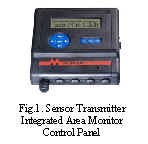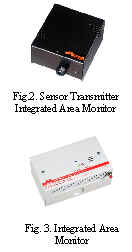|
Dr.
Lorcan J. Maher Far-reaching International Standards and Regulations Requiring Refrigerant Leak Detection Still Not Generally Known |
AutomatedBuildings.com
|
[an error occurred while processing this directive] |
|
Dr.
Lorcan J. Maher Far-reaching International Standards and Regulations Requiring Refrigerant Leak Detection Still Not Generally Known |
"A high proportion of the users of refrigeration and air-conditioning world-wide are still simply unaware of the wide-ranging implications of prevailing Standards - and the same could be said even of a surprising number of professionals in the equipment and service sectors." This was the challenging assertion by Dr Lorcan J. Maher, Managing Director of MURCO, one of Europe's leading manufacturers of advanced refrigerant leak detection equipment.
"Invariably the key point of these Standards is all-embracing and applies to all refrigeration and air conditioning installations," said Dr Maher. "Most Standards state unambiguously that at all times, care should be taken to minimize the discharge of refrigerant to the atmosphere.'
The seriousness of leaking systems was until recently - if not still - of comparatively little concern to the industry. Most plant operators found it easier to top up leaking systems with refrigerant, rather than to find leaks and operate tight systems. In fact historically some 70% of refrigerant has been used simply for topping up leaks.
|
|
|
|
|
|
|
|
|
|
|
|
|
|
|
[an error occurred while processing this directive] |
This started to change with the Montreal Protocol in 1987, which formalized a response to the damage being caused to the ozone layer by ozone depleting substances. With the subsequent international phase-out program for CFCs and HCFCs the replacement cost of refrigerant leaks started to become of concern but even still few operators took the positive step of installing gas leak monitors.
The ISO Standard 5149: 1993(E) was the response to the Montreal Protocol and updated the previous Standard and incorporated the requirement to use Leak Detectors. It applies in all member countries of the International Standards Organization in Europe, USA, and includes such major Asian countries as China, Japan, Korea, Singapore, India and Pakistan. Geographically, worldwide including the USA, Europe, Australia, New Zealand, and South Africa responded to the Protocol by introducing their own supplementary regulations or standards requiring the installation of fixed leak monitors in refrigeration and air conditioning machinery rooms based on the ISO 5149 Standard.
Europe
The European Union and CEN countries responded in 2000 by introducing
Regulation 2037/2000 requiring that action be taken to prevent leakage and the
new European Standard EN378 Refrigerating Systems and Heat Pumps - Safety and
Environmental Requirements based on ISO 5149. This requires the installation of
fixed refrigerant leak monitors in all refrigeration and air-conditioning
machinery rooms. Dr Maher points out that since the end of 2000 it supersedes
all national standards in EU countries.
USA
ASHRAE 15-1994 and Unified Mechanical Code 1994 were introduced and
again both require the installation of fixed refrigerant leak monitors in all
refrigeration and air-conditioning machinery rooms.
Australia / New
Zealand
Introduced AS/NZ 1677.2
S. Africa
Introduced SABS 0147:1995
As well as the common requirement to fit leak detectors in all machinery rooms and to take special precautions with comfort air conditioning, each standard has particular requirements and should be reviewed independently. Brief summaries, reflecting our view, on EN378, ASHRAE 15, Unified Mechanical Code, SABS 0147, and AS/NZ 1677.2 may be viewed on our web site, www.murco.ie
[an error occurred while processing this directive]Most countries in the world require the use of fixed leak detectors in all refrigeration and air -conditioning machinery rooms. In addition most issue strong warnings on the dangers of refrigerant leaks into occupied spaces with direct air-conditioning systems such as VRV / VRF and they limit the charge of refrigerant allowed. Some require special precautions to be taken, including the use of fixed leak detectors. Generally if leak detectors are fitted extra refrigerant charge in the system is possible.
The major manufacturers of such systems including Mitsubishi, Toshiba, Fujitsu, Daikin and others have identified the danger of leaks with direct systems and refer to the Standards with appropriate warnings in their technical manuals. They generally recommend extra ventilation and / or the use of leak detectors.
Safety at Work Legislation
There is also in most countries a volume of safety legislation covering occupational exposure that requires that workers not be exposed to harmful gases, including refrigerants, above the recommended limits. This should be complied with, in the interests of worker safety. But in fact failure to do so could expose the operator to compensation claims. Gas leak monitors would show compliance and minimize this risk.
Climate Change Taxes Add Motivation
Worldwide, countries are committed to honouring their obligations to minimizing global warming.
The EU is committed to introducing regulations to implement its commitment to the Kyoto Protocol on Climate Change and these may serve as a model to other countries.
Within the EU, Denmark has implemented massive taxes on refrigerants at the point of purchase and the UK has implemented reward/punishment taxation measures that are more likely to serve as the European model.
The new UK Climate Change Levy on energy consumption adds an additional and very real cost motivation to install detectors. This is a measure aimed at ensuring the achievement of the UK's target reduction of greenhouse gas emissions. An inefficient refrigeration plant, often caused by refrigerant leaks, also consumes excessive energy and this will result in a substantial tax penalty for the operator. The balancing incentives include the Enhanced Capital Allowance Scheme under which an operator can claim the full cost of an investment in specified qualifying technologies, including Murco Leak Detectors, against taxable income, i.e. 100% in the first year.
Smart Range of Systems
 Gas
leak detectors are the front line instruments in the industry's response to the
challenging comprehensiveness of the ISO 5149 and other Standards and the
Climate Change Levy. Dr Lorcan J. Maher announced that MURCO has launched a new
generation of gas leak detection equipment, including new products aimed
specifically at the air-conditioning compliance needs generated by the Standards.
These will complement what is already the most comprehensive range of machinery
room gas leak detection equipment on the market.
Gas
leak detectors are the front line instruments in the industry's response to the
challenging comprehensiveness of the ISO 5149 and other Standards and the
Climate Change Levy. Dr Lorcan J. Maher announced that MURCO has launched a new
generation of gas leak detection equipment, including new products aimed
specifically at the air-conditioning compliance needs generated by the Standards.
These will complement what is already the most comprehensive range of machinery
room gas leak detection equipment on the market.
MURCO is a specialist manufacturer that has over the years developed highly successful gas leak detection systems now used in thousands of refrigeration and air conditioning installations worldwide. Its sensor range includes state-of-the-art catalytic, semiconductor, electrochemical and infrared models and sensor transmitters to detect gas leaks in an area, room, zone, airspace or airflow.
 The
extensive MURCO systems are based in the first instance on its state-of-the-art
range of Gas Leak Monitors / Detectors, offering 1, 2, 4 and 6 channel monitors
with remote sensors and a choice of one or two levels of detection. All have
visual and audible alarms and relays for control or remote reporting. Available
for all refrigerants and most other problem gases, they are used extensively in
machinery room applications and in marine applications to ensure compliance with
international maritime conventions and regulations. All MURCO units incorporate
constant power and system fault monitoring as standard.
The
extensive MURCO systems are based in the first instance on its state-of-the-art
range of Gas Leak Monitors / Detectors, offering 1, 2, 4 and 6 channel monitors
with remote sensors and a choice of one or two levels of detection. All have
visual and audible alarms and relays for control or remote reporting. Available
for all refrigerants and most other problem gases, they are used extensively in
machinery room applications and in marine applications to ensure compliance with
international maritime conventions and regulations. All MURCO units incorporate
constant power and system fault monitoring as standard.
The MURCO Integrated Area Monitor detects gas leaks in an area, room, zone, airspace or airflow. It has constant power and fault monitoring and two relays to control external equipment, e.g. fans, air conditioning units, etc. It can function as a stand-alone area monitor / detector with audible and visual alarm but also has a dedicated output to report to a remote MURCO Control Panel that has audible and visual warning of alarms and a range of relays for control purposes. These control panels may be linked to create very large systems.
The MURCO Sensor Transmitter Integrated Area Monitor series with linearized outputs is designed to interface with third party BMS, equipment, and controllers as well as a MURCO control panel using its selectable outputs of 0-5V, 0-10V, 4-20mA, RS485 and relays. This stand-alone monitor is also available in an explosion proof version. The MURCO control panel, which can monitor up to 99 remote sensor transmitters through its RS485 port, offers many features including visual and audible alarms with graphic display, data storage, printer interface and modem or PC connection to activate service or emergency call-outs.
MURCO products and designs are rapidly becoming the refrigeration / air-conditioning industry standard. Based in Ireland, MURCO has developed systems that are distributed worldwide. They allow full compliance with all relevant Standards including ISO 5149, EC Regulation 2037/2000 and EN378 and the USA standards ANSI/ASHRAE 15-1994 as well as meeting most insurance, work safety and maritime codes and best practice solutions.
[an error occurred while processing this directive]
[Click Banner To Learn More]
[Home Page] [The Automator] [About] [Subscribe ] [Contact Us]